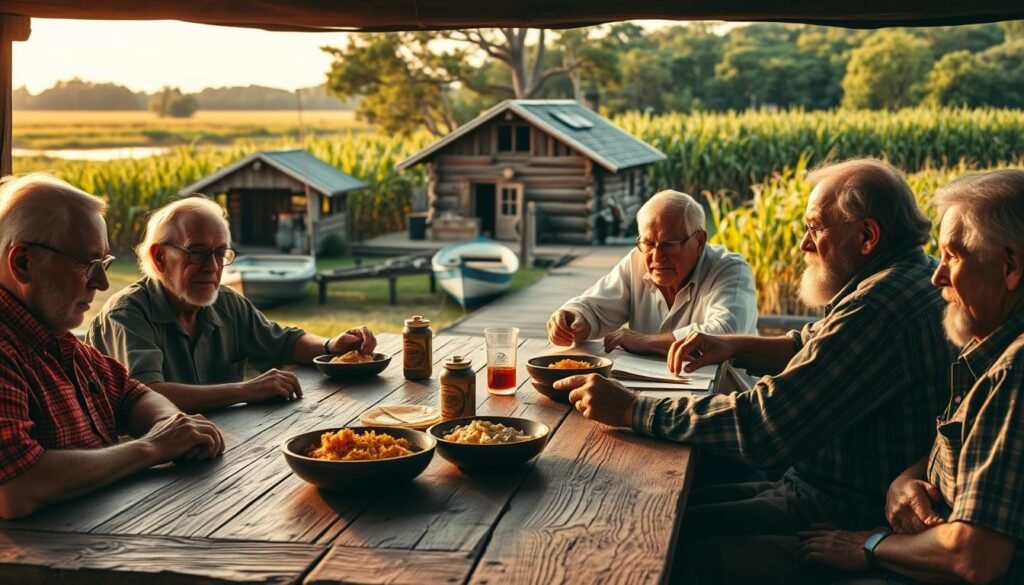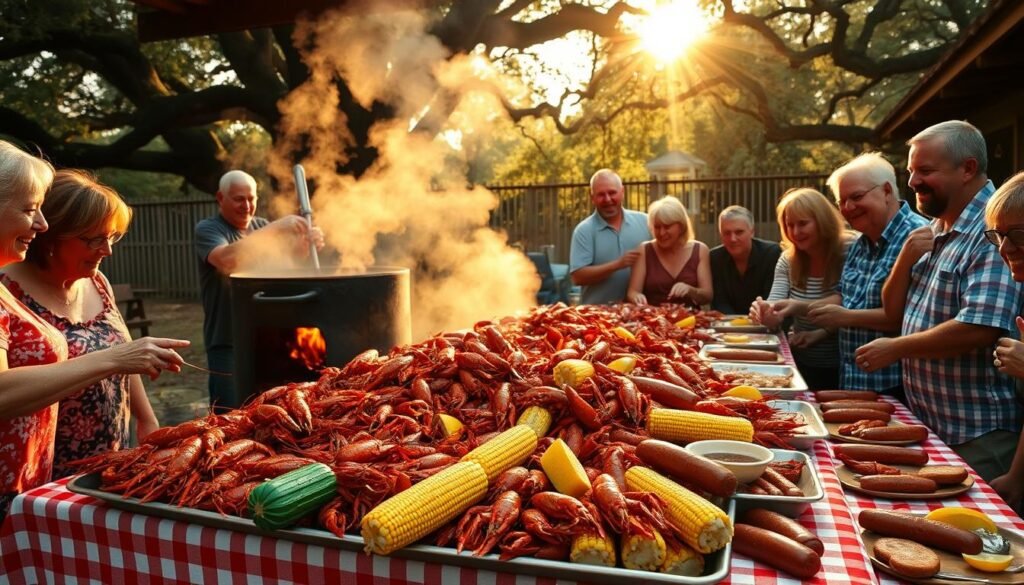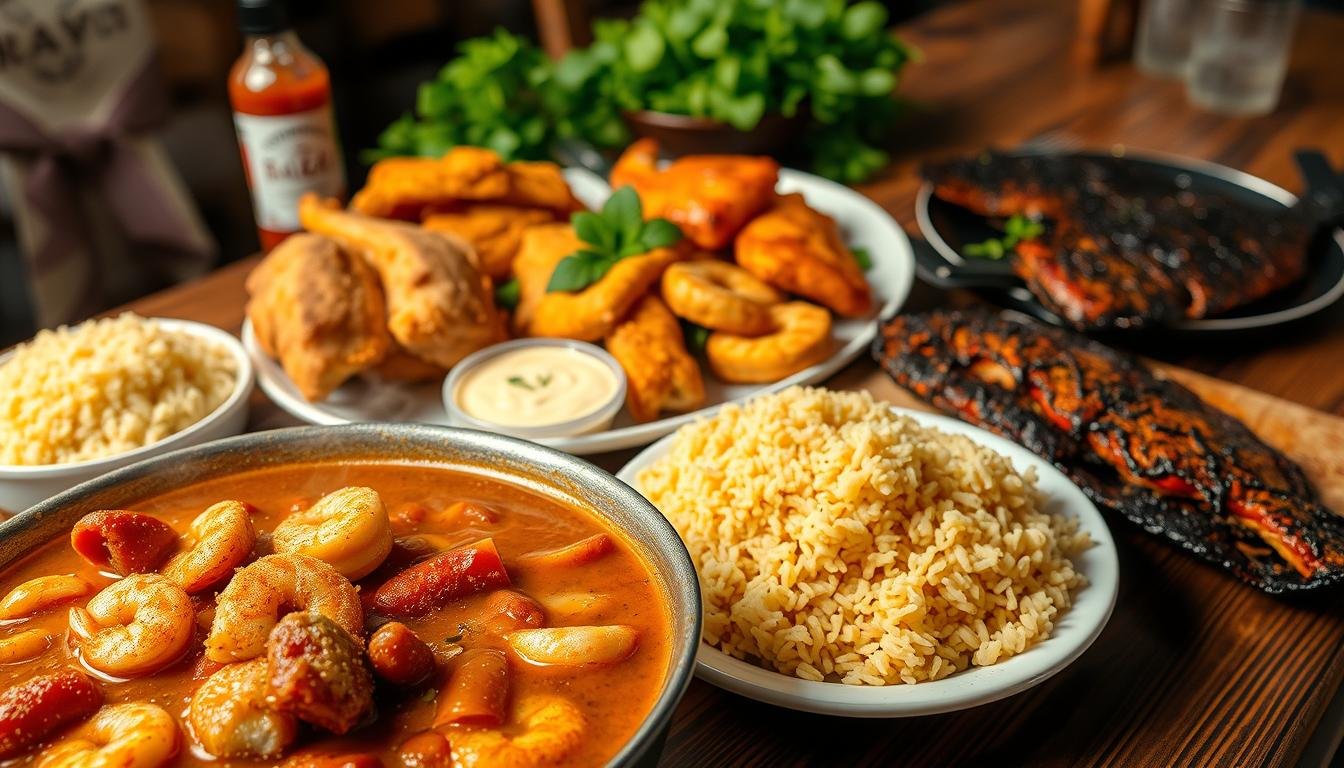Pull up a chair — I’ll set the table like we do back home in southern Louisiana. We talk about food that grew from hard work, wetland harvests and one-pot comfort. A pot of gumbo tells history in every stir.
From the bayous to New Orleans, place shapes flavor. Our people mixed Native American, West African and French roots here, and that blend made dishes that travel well across the United States.
Think rice, shrimp and seafood simmered with the trinity of peppers, onion and celery — simple, bold, honest. We’ll share how our cooking style shows up at backyard boils, restaurants and Mardi Gras tables.
This guide is an insider’s map: a bit of past, a lot of flavor, and straight talk about what’s authentic and what just wears the label. Read on for techniques, staples and stories that keep the tradition alive.
Key Takeaways
- Roots: the food grew from exiles and many cultural influences.
- Essence: one-pot dishes like gumbo blend rice, seafood and spice.
- Place matters: wetlands, rivers and New Orleans shape style.
- Tradition lives in homes, restaurants and Mardi Gras gatherings.
- Cooking is practical — smothering, boiling, frying with care.
What Is Cajun Cuisine? Defining a Rustic, One-Pot Louisiana Tradition
Born beside rice fields and river bends, the style here is plain, hearty, and honest. I speak as someone who learned at a family stove: big pots, simple rules, and food made to feed a room.
From bayous to table, this tradition relies on what the land and water give us. Rice often plays the starring role—catching gravy and carrying shrimp or chicken so one dish fills many mouths.
From bayous to table: a cuisine rooted in place, people, and rice
We cook for people—neighbors, family, visitors. The area shapes the pantry: rice fields, gardens, and river catches decide what simmers. That practicality makes the food both humble and rich.
The “holy trinity” vs. French mirepoix: bell pepper, onion, and celery
Our cooking process usually begins with the holy trinity—green bell pepper, onion, and celery—sweated until soft. It’s a riff on the French mirepoix, swapping carrots for peppers so the base leans brighter and earthier.
“You can tell a pot that was made with place and patience—those layers of aromatics do the talking.”
- Heat stays balanced; flavors build from parsley, bay leaf, thyme, and pepper.
- Common dishes like gumbo and étouffée start with that same aromatic bed.
- West African echoes meet French technique—simple steps, big reward.
The History of Cajun Cuisine: From Acadian Exile to Southern Louisiana
Our story begins with people pushed from one shore to another, carrying pots and recipes in their hands. In the mid-18th century, Acadian families were expelled during le Grand Dérangement. Those 18th century immigrants landed in southern louisiana and rebuilt homes and kitchens.
Le Grand Dérangement and new homelands
These immigrants mixed French habits with what the bayou gave them. They learned hunting, fishing, and how to stretch a meal for many.
Blending of traditions
Native American, west african, French, and Spanish influences met in one pot. Enslaved people and arrivals from the West Indies added techniques and ingredients that shaped sauces and staples.
Staples and signature dishes
Gumbo shows that West African link—okra (gombo) thickened stews that fed whole communities. Early diets shifted from cornbread and cane syrup to rice and gravy as fields and waterways set the pantry.
“You can taste history in a pot: survival, sharing, and place all ladled over rice.”

| Period | Staples | Key Influences |
|---|---|---|
| Mid-18th century | Cornbread, cane syrup | French Acadian traditions |
| Late 18th–19th century | Rice, gumbo, crawfish, chicken | West African, Native American, Spanish |
| Modern era | One-pot dishes, rice gravy, smoked meats | New Orleans influence, regional variation |
Flavor Foundations: The Holy Trinity, Cajun Spices, and Roux
The smell that hits the kitchen first usually comes from the pan where the trinity does its work. I mean the green bell pepper, onion, and celery—the holy trinity—sweated slow so their sweetness softens and the base aroma builds.
Seasoning comes next: parsley, bay leaf, thyme, green onions, with cayenne and black pepper to lift the heat. A splash of Louisiana-style hot sauce joins when the dish asks for a little bite—not to overpower, but to balance.
Roux is the backbone. Made with oil or rendered fat, not butter, it’s stirred low-and-slow for 15–45 minutes until it turns mahogany and smells nutty. Miss the timing and the whole pot will tell you.
Gumbo, shrimp étouffée, and chicken dishes all change with the roux’s color—blond, brown, or dark—so color equals flavor in our playbook.
“Watch the flame, trust your nose, and keep stirring—good flavor comes from patience.”
- First sweat the trinity to build aroma before adding proteins or stock.
- Use cayenne and black pepper for steady heat; herbs and hot sauce round it out.
- Make the roux long and slow; it gives body to rice, seafood, sausage, boudin, and fish dishes.
Classic Cajun Cooking Methods and Techniques
Hands-on techniques shape flavor: slow heat, steady stirring, and a bit of local know-how. The approach matters more than fancy tools — how you sweat the trinity, brown a roux, or tend a boil changes everything.
Smothering and braising mean onions, bell, and celery first, then meat, a splash of stock, and low heat until you have rich rice gravy. Étouffée is a close cousin — small pan, big comfort.

Seafood boils and community
A crawfish boil is equal parts cooking and gathering. Crawfish, shrimp, or blue crab go in with corn and potatoes, and the table becomes the loudest part of the party.
Grill, smoke, and fry
We smoke and grill for depth — pork sausage low and slow, links crisp at the edges. Deep-frying turns catfish, oysters, or shrimp into perfect po’ boy filling, especially with a drizzle of remoulade.
Stewing and fricassée
Fricassée and stews take patience: chicken or pork simmers until the sauce is silky. Many recipes finish with a spoonful of roux to bind the flavors.
“Technique makes a pot speak — tend the fire and the meal will tell you when it’s ready.”
Iconic Cajun Dishes and Ingredients
A single pot can hold shrimp, sausage, rice, and a whole neighborhood’s memory. These plates show how the land, the smokehouse, and the dock meet on a fork.
Gumbo is the state’s calling card—built on a roux and the trinity. Houses serve seafood gumbo, chicken gumbo, or sausage gumbo, and each one tastes a little different depending on stock and timing.
Rice-led one-pot meals
Jambalaya puts rice to work. It soaks up juices from shrimp, andouille, and chicken, making a full meal in one pan.
Smoked meats and sausages
Boudin is a cooked sausage of pork, rice, and green onions—sometimes with liver or seafood mixed in. Pork sausage cooks finer than andouille; tasso, a highly seasoned smoked shoulder, lifts stews with a spoonful of smoke.
Shellfish and local fish
Crawfish reign in boils and in étouffée—shellfish at the heart of the table when season hits. Catfish and other local fish tell a changing story: wild harvests gave way to Delta farmed fillets, but the plates still sing of wetlands and prairies.
“These dishes are how many first meet the cuisine—and they are everyday food for us: made to share, made to satisfy.”
- Gumbo anchors with roux and trinity.
- Jambalaya makes rice the star.
- Boudin and sausage keep smokehouses busy.
- Crawfish and étouffée highlight shellfish seasons.
Regions and Styles: Rural Cajun vs. New Orleans and the Teche Country
Small miles change the pot—each parish seasons slightly different. I say that because place writes the recipe here. The same dish will dress itself another way depending on smoke, salt, or a garden’s gift.
Rural Acadiana: Home pots and rice traditions
Out in rural Acadiana we keep one-pot meals at the center. Rice sits ready to catch gravy and stretch a meal for a family.
Gardens, smoked pork, and boudin show up on tables. Simple, steady cooking—made for workdays and Sundays alike.
New Orleans and Creole contrasts
New Orleans grew differently—Creole roots meet global trade and refined technique. The tools and ingredients overlap, but gumbo in town often tastes different than down the bayou.
Teche country and the prairies
Along the Bayou Teche seasoning sits in the middle—more cayenne than the bayou, less than the open prairies. The prairies favor smoke: sausage links, pork sausage, and tasso from the smokehouse.
Coastal spots lean on seafood and crawfish—boiled for crowds or folded into sauces. You find andouille near the old German Coast and rice gravy showing up where rice rules the plate.
Quick regional snapshot:
| Region | Typical Staples | Signature Seasoning / Item |
|---|---|---|
| Rural Acadiana | Rice, one-pot meals, garden vegetables | Rice gravy, home-smoked pork |
| New Orleans | Seafood, complex sauces, city-style stews | Creole spice blends, city gumbo |
| Bayou Teche & Prairies | Boudin, tasso, sausage, smoked meats | Balanced cayenne, smoked pork |
| Coastal parishes | Crawfish, shrimp, fish | Crawfish boil, fresh seafood salt |
“Dishes may look alike, but local hands and local heat make them their own.”
Cajun Cuisine in Modern America
What started in backyard stoves has spread into diners and city menus nationwide. I watch it with pride—some places hold the truth, others wear the label.
From home kitchens to restaurants: authenticity, tradition, and The Lost Cajun
These days you’ll find cajun food from small-town diners to national spots. The Lost Cajun stayed old-school—an oil-and-flour roux cooked down twice and checked for the right viscosity. That gumbo test tells you everything.
Menus travel well: gumbo, jambalaya, po’ boys, hushpuppies, gator bites, sausage plates. Still, the heart beats strongest in family kitchens where recipes move by stirring and taste.
Mardi Gras, family gatherings, and cultural identity in the United States
Mardi Gras pulls it together—pots on the stove, platters on the table. Crawfish and rice show up alongside the music and the laugh of family.
“You can leave Louisiana, but the roux, the recipes, and the stories come with you.”
Across the united states, this cuisine carries identity. When you pick restaurants, look for patience in the pot—slow gumbo, smoky sausage, cooks who explain why they do it. That patience keeps the food honest and popular cajun dishes true to their roots.
Conclusion
Good meals keep history alive: slow roux, shared rice, and a seat at the table. I believe that the story of cajun cuisine began in the 18th century and lives in each simmered pot.
From gumbo to a mess of sausage and rice, these cajun dishes tie family, labor, and flavor together. Modern spots — even The Lost Cajun — try to carry the same patient techniques beyond Louisiana.
So taste the roux, listen for the stories, and bring people to the table. That’s how we honor history: not in a museum, but in a warm bowl at Mardi Gras, Sunday supper, or any kitchen that remembers how to stir.
FAQ
What is Cajun cuisine?
It’s a rustic, one-pot tradition from southern Louisiana built around local ingredients — rice, pork, seafood and strong, soulful gravies — born of Acadian exile and shaped by local gardens, bayous and family kitchens.
What is the “holy trinity” in this cooking style?
The holy trinity refers to bell pepper, onion and celery. Those three aromatics start most dishes here, giving a base of flavor similar in purpose to French mirepoix but with its own Southern feel.
How did this food develop historically?
After Le Grand Dérangement in the 18th century, Acadian immigrants settled in Louisiana and blended French techniques with Native American, West African and Spanish ingredients. That mix, plus local staples like rice and cane syrup, created what we eat today.
What role do West African influences play?
Many techniques and ingredients trace back to West Africa — okra in gumbo is a clear example — along with stewing methods and spice approaches that shaped classic dishes.
What’s the difference between a light and dark roux?
A light roux cooks briefly and thickens without much color. Dark roux cooks longer until it turns brown or chocolate-colored, giving nutty, deep notes essential in hearty gumbos and some stews.
Which spices define the flavor profile?
Heat and balance come from cayenne, black pepper and Louisiana-style hot sauces, alongside garlic, paprika and bay leaf. The goal is bold, balanced seasoning that sings with the mains.
How do traditional cooking methods differ here?
You’ll find smothering and braising for gravy-rich plates served over rice, communal seafood boils for crawfish and shrimp, plus grilling, smoking and quick deep-frying for catfish, oysters and po’ boys.
What are the region’s signature dishes?
Gumbo, jambalaya, étouffée and crawfish boils lead the list. Also boudin and smoked pork items like tasso — these came from smokehouses to family tables across Acadiana and New Orleans.
How does rural Acadiana cooking differ from New Orleans Creole styles?
Rural cooking leans on one-pot, garden-focused meals and rice. New Orleans dishes often blend French city techniques with Caribbean and European influences. They share roots but carry distinct seasonings and presentation.
Can I recreate authentic flavors at home?
Absolutely. Start with the holy trinity, use a proper roux, choose good sausage like andouille, and don’t rush long simmers. Fresh seafood and patience will get you closest to that home-kitchen taste.
What’s the best way to enjoy a crawfish boil?
Gather friends, spread newspaper, steam live crawfish with potatoes and corn, season generously, and eat with your hands — simple, social and full of Southern warmth.
How has this food evolved in modern America?
It’s everywhere now — from family tables to restaurants. Chefs keep tradition alive while experimenting. Festivals, Mardi Gras and local restaurants help preserve identity even as dishes adapt.
Are there sustainability concerns with local seafood?
Yes. Populations of shrimp, crab and certain fish shift with seasons and environmental pressures. Buy seasonal, ask local sellers about sourcing, and favor regulated fisheries when you can.
What common mistakes should home cooks avoid?
Rushing a roux, skimping on seasoning, and overcooking seafood are frequent missteps. Slow down, taste often, and respect timing — that’s where the real flavor lives.
Where can visitors find authentic experiences?
Look for family-run spots, local smokehouses, and community festivals in Acadiana and New Orleans. Ask locals — we’ll point you to the spots that keep tradition alive.
